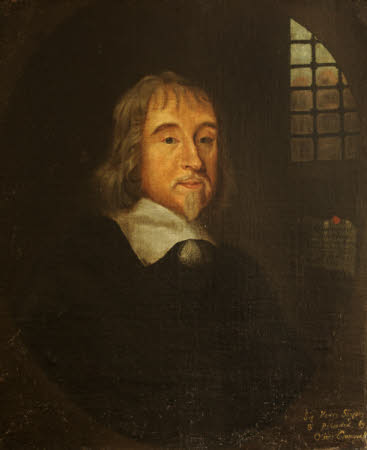Sir Henry (Harry) Slingsby, 1st Bt of Scriven (1602-1658)
British (English) School
Category
Art / Oil paintings
Date
circa 1660 - 1665
Materials
Oil on panel
Measurements
762 x 635 mm (30 x 25 in)
Place of origin
England
Order this imageCollection
Lacock, Wiltshire
NT 996318
Caption
Harry Slingsby was the father of Barbara Slingsby, 2nd wife of Sir John Talbot MP (d.1714), who was beheaded at the Tower of London by Oliver Cromwell. In 1655 he was implicated in a projected Royalist uprising in Yorkshire, and imprisoned in Hull. The Government decided to make an example of him and he was executed on Tower Hill on 8 June 1658. Sir Harry’s, ‘Diary’, kept between 1638 and 1648, not only gives a valuable account of the Civil War in Yorkshire, but also provides a vivid picture of the life of a country gentleman there. It was first published, in an abbreviated form, by Sir Walter Scott in 1806, and fully in 1836. This portrait would have served as a private family memorial.
Summary
Oil painting on panel, Sir Henry (Harry) Slingsby, 1st Bt of Scriven (1602-1658), English School, circa 1660/65. A half-length portrait, to right in black with white collar, with prisons bars shown right background.
Full description
Father of Barbara Slingsby, the 2nd wife of Sir John Talbot, MP (d.1714), a sacrificial victim of the Royalist cause, and diarist. In the DNB his approach to religion is described as combining ‘something of the ‘painful’ earnestness of the godly with the reverence for order and decency of the Arminians.’ The son of Sir Harry Slingsby, Kt. (1565 - 1634), Vice-President of the Council of the North (1629 ff.), of Scriven, Yorks., and Frances Vavasour of Weston, this Sir Harry became heir to the family estate upon the death of his brother in 1617 (see entry in the D.N.B). He entered Queen's College, Cambridge as a fellow-commoner in 1618/19, but left without taking a degree. He took over his father’s seat at Knaresborough in 1625, in the first Caroline parliament, but did not stand, or was defeated in the 1626 elections. He travelled abroad, but by 1628 had returned to Knaresborough, where again he stood, but lost. In 1631 he married Lady Barbara Belasyse (bap. 1609, †1641), daughter of Thomas, 1st Vt. Fauconberg of Newburgh Priory, Yorkshire, and prominent church papist. On 2 March 1638 he was made a Baronet of Nova Scotia. Slingsby served in Lord Holland's troop in the First War against the Scots (1639), represented Knaresborough in both the Parliaments of 1640, when he voted against the impeachment of Strafford; and, whilst supporting the removal of the bishops from the House of Lords, voted against the abolition of the episcopacy. Thereafter, he joined and took up arms with the Royalist cause, finally retreating to his home at Redhouse after the defeat of Newark in 1646. There, he long lived in one room, to avoid arrest, and - refusing to compound for his estate because it would have meant taking the negative oath of allegiance - saw it sold (though it was bought by his relatives Slingsby Bethel & Robert Stapleton, as trustees for himself and his children). In 1655 he was implicated in a projected Royalist uprising in Yorkshire, and sent prisoner to Hull. There, he was inveigled by agents provacateurs into trying to solicit them for the Royal cause; and the Government, anxious to check the endless succession of Royalist plots, decided to make an example of him. He was executed on Tower Hill on 8 June 1658. Slingsby left two sons - Sir Thomas, 2nd Bt. († c.1685); and Henry, one of the Gentlemen of the Privy Chamber to Charles II; and one daughter, Barbara, who married Sir John Talbot, M.P. Sir Harry’s, ‘Diary', kept between 1638 and 1648, not only gives a valuable account of the Civil War in Yorkshire, but also provides a vivid picture of the life of a country gentleman there, thanks to his emulation of Montaigne in recording what others would have dismissed as trivia. It was first published, in an abbreviated form, by Sir Walter Scott in 1806, and fully in 1836
Provenance
by descent, through the sitter's daughter, Barbara, second wife of Sir John Talbot, until given by Matilda Theresa Talbot (formerly Gilchrist-Clark) (1871 – 1958), who gave the Abbey, the village of Lacock and the rest of the estate to the National Trust in 1944, along with 96 of the family portraits and other pictures, in 1948
Credit line
Lacock Abbey, The Talbot Collection (National Trust)
Marks and inscriptions
Bottom right: Sir Harry Slingsby/ Bt. Beheaded by / Oliver Cromwell
Makers and roles
British (English) School, artist

